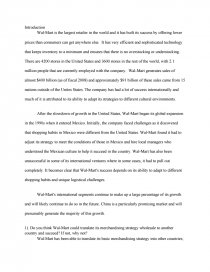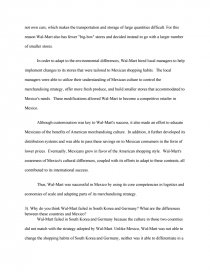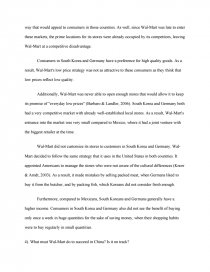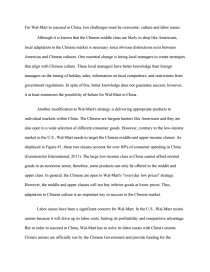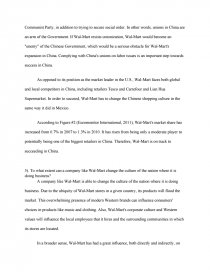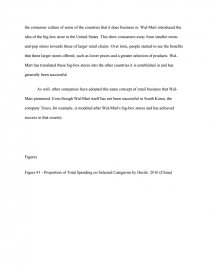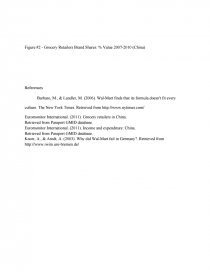Walmart's Foreign Expansion
Essay by people • July 29, 2012 • Case Study • 2,029 Words (9 Pages) • 5,358 Views
Introduction
Wal-Mart is the largest retailer in the world and it has built its success by offering lower prices than consumers can get anywhere else. It has very efficient and sophisticated technology that keeps inventory to a minimum and ensures that there is no overstocking or understocking. There are 4200 stores in the United States and 3600 stores in the rest of the world, with 2.1 million people that are currently employed with the company. Wal-Mart generates sales of almost $400 billion (as of fiscal 2008) and approximately $91 billion of these sales came from 15 nations outside of the Unites States. The company has had a lot of success internationally and much of it is attributed to its ability to adapt its strategies to different cultural environments.
After the slowdown of growth in the United States, Wal-Mart began its global expansion in the 1990s when it entered Mexico. Initially, the company faced challenges as it discovered that shopping habits in Mexico were different from the United States. Wal-Mart found it had to adjust its strategy to meet the conditions of those in Mexico and hire local managers who understood the Mexican culture to help it succeed in the country. Wal-Mart has also been unsuccessful in some of its international ventures where in some cases, it had to pull out completely. It becomes clear that Wal-Mart's success depends on its ability to adapt to different shopping habits and unique logistical challenges.
Wal-Mart's international segments continue to make up a large percentage of its growth and will likely continue to do so in the future. China is a particularly promising market and will presumably generate the majority of this growth.
1). Do you think Wal-Mart could translate its merchandising strategy wholesale to another country and succeed? If not, why not?
Wal-Mart has been able to translate its basic merchandising strategy into other countries; however, it has had to alter parts of its strategy to adapt to local consumer culture. Wal-Mart can be successful in countries where it can adapt to cultural shopping differences, those of which do not conflict with Wal-Mart's merchandising strategy as a whole.
The reason that Wal-Mart cannot translate its strategy directly to every country in which it does business in is because each country needs some degree of tailoring to meet local tastes. For example, an American manager in China would be foolish to think that if he stocked the shelves with Easter bunnies that revenues will increase around Easter time. Not everyone celebrates the same holidays and not everyone values the same things. Culture should influence how a company decides to do business in another country.
Wal-Mart needs to take into consideration not only varying religious beliefs, but also differences in social structure, norms, and value systems. If retailers such as Wal-Mart do not address these significant cultural differences, it would be impossible to be successful.
2). Why do you think Wal-Mart was successful in Mexico?
Wal-Mart was successful in Mexico because it was able to recognize the cultural variations from that of the United States and adapt its strategy accordingly.
Wal-Mart entered Mexico in the early 1990s by entering in a joint venture with the largest Mexican retailer, Cifra. This gave Wal-Mart access both to prime locations within Mexico and Cifra's retail knowledge and experience.
There are many dissimilarities in shopping habits between Mexico and the United States that needed to be addressed if Wal-Mart were to have longevity. Firstly, Mexicans prefer to buy fresh produce and food in smaller quantities than consumers in the U.S. This stems from cultural differences between the two countries. In Mexico, many people lack large refrigerators and do not own cars, which makes the transportation and storage of large quantities difficult. For this reason Wal-Mart also has fewer "big-box" stores and decided instead to go with a larger number of smaller stores.
In order to adapt to the environmental differences, Wal-Mart hired local managers to help implement changes to its stores that were tailored to Mexican shopping habits. The local managers were able to utilize their understanding of Mexican culture to control the merchandising strategy, offer more fresh produce, and build smaller stores that accommodated to Mexico's needs. These modifications allowed Wal-Mart to become a competitive retailer in Mexico.
Although customization was key to Wal-Mart's success, it also made an effort to educate Mexicans of the benefits of American merchandising culture. In addition, it further developed its distribution systems and was able to pass these savings on to Mexican consumers in the form of lower prices. Eventually, Mexicans grew in favor of the American shopping style. Wal-Mart's awareness of Mexico's cultural differences, coupled with its efforts to adapt to these contrasts, all contributed to its international success.
Thus, Wal-Mart was successful in Mexico by using its core competencies in logistics and economies of scale and adapting parts of its merchandising strategy.
3). Why do you think Wal-Mart failed in South Korea and Germany? What are the differences between these countries and Mexico?
Wal-Mart failed in South Korea and Germany because the culture in those two countries did not match with the strategy adopted by Wal-Mart. Unlike Mexico, Wal-Mart was not able to change the shopping habits of South Korea and Germany, neither was it able to differentiate in a way that would appeal to consumers in those countries. As well, since Wal-Mart was late to enter these markets, the prime locations for its stores were already occupied by its competitors, leaving Wal-Mart at a competitive disadvantage.
Consumers in South Korea and Germany have a preference for high quality goods. As a result, Wal-Mart's low price strategy was not as attractive to these consumers as they think that low prices reflect low quality.
Additionally, Wal-Mart was never able to open enough stores that would allow it to keep its promise of "everyday low prices" (Barbaro & Landler, 2006). South Korea and Germany both had a very competitive market with already well-established local stores. As a result, Wal-Mart's entrance into the market was very small compared to Mexico, where it had a joint venture with the biggest retailer at the time.
Wal-Mart did not customize its stores to customers in South Korea and Germany. Wal-Mart
...
...
